Top News
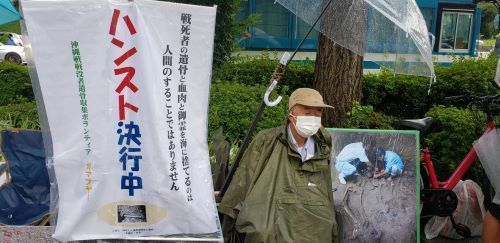
August 15, 2021 Ryukyu Shimpo
Tokyo – On August 15, Memorial Day for the End of the War, Takamatsu Gushiken continued his hunger strike in front of the Nippon Budokan in Chiyoda. He began the hunger strike on August 14. Gushiken is a representative of the Gamafuya, a group of volunteers who search for the remains of those who died in the Battle of Okinawa. Addressing those attending the National Memorial Service for the War Dead and the relatives of the war dead who were paying their respects at Yasukuni Shrine, Gushiken called for a halt in plans to use soil from the southern part of Okinawa’s main island, where there are still remains of the war dead that haven’t been found, in the land reclamation for the construction of the new base at Henoko.
Gushiken, who has been subsisting on only water and tea since August 14, protested silently, sometimes in pouring rain. He says, “A lot of people asked me why I was there, and many of them didn’t know anything about this issue.” He clearly saw that there is a vast difference in how Okinawans and people in Honshu feel about the issue. He adds, “Two years ago, I was here calling for DNA testing on the remains, but the Ministry of Defense seems to be moving away from DNA testing, which is a national undertaking. Today is a day for us to honor those who died in the war, so today, in particular, I want the people of mainland Japan to learn about this issue.”
On August 15, people who agree Gushiken’s work helped gather support by holding banners and passing out flyers demanding a halt in the plans to use the soil. Hiroshi Tamura came from Chiba to participate in the protest. His father was deployed and died in battle in the southern part of Okinawa’s main island. Tamura continues to visit Okinawa three to four times each year, searching for his father’s remains with Gushiken. He says, “I was three at the time, and have almost no memories of my father, so for me, his remains are proof that my father lived. The Ministry of Defense’s plan robs families of the war dead of the chance to find their family member’s remains. It’s unforgivable.”
(English translation by T&CT and Ellen Huntley)
Go to Japanese
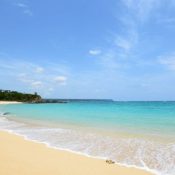
August 16 2021 Ryukyu Shimpo
According to the Okinawa Meteorological Observatory (OMO) the Okinawa archipelago has yet to record an extremely hot day, meaning a high temperature exceeding 35 degrees Celsius, in 2021 as of August 12. Meanwhile, Areas such as the Kanto region has seen continuing oppressive heat this summer with a number of heat waves. This is due to Okinawa’s climate, which is dependent on ocean temperature, which sees only minor changes in temperature throughout the year, meaning that compared to other parts of Japan it is difficult for the temperature in Okinawa to reach extreme highs.
The Okinawan climate in most years will see its temperature peak just after the end of the rainy season at the end of July, when a high-pressure system covers the Pacific. The most recent heat wave was recorded over five days starting July 16, 2020 in Hateruma, Yonaguni Island, and Tokorono in Yonaguni Village.
An extreme heat day has not been recorded on Okinawa’s main island since August 21, 2017 when Izena hit 35 degrees. Excluding the outlying islands, there was also a temperature of 35.1 recorded in Itokazu, Nanjo that same year on August 12.
The hottest days this year were July 13 in Iriomote, which hit 34.4, and on Okinawa’s main island where it reached 34 degrees on July 19 in Ashimine, Naha.
According to the OMO, factors that make it hard for Okinawa to experience days of high heat include 1. The ocean climate due to Okinawa being surrounded by ocean; 2. The lack of high mountains preventing the area from being affected by the foehn phenomenon; and 3. Only having a small portion of the island covered in concrete prevents the heat island effect. In particular, the wind blowing steadily over the islands from the ocean keeps the air cool, which is a major factor.
According to the “Okinawa Climate Change Outlook Report 2021” released by the OMO, the Okinawa region will see an average increase in temperature of 1.21 degrees over the next century, with summer days over 30 degrees increasing by 2.8 days over the next 10 years, and nights over 25 degrees increasing by 5.7 days. Meanwhile, comparing the temperature in Naha to the previous year, for days summer days that surpassed a high temperature of 30 degrees between July 1 and August 11, 2020 recorded 40 such days while 2021 only had 35, showing that the temperature has not been rising this year.
However, according to the OMO also noted that Aguni Island recorded an extreme heat day in September 2017, and to still be cautious of hot days moving forward, and that it was essential to always drink plenty of water.
(English translation by T&CT and Sam Grieb)
Go to Japanese

August 12, 2021 Ryukyu Shimpo
Ogimi – In the approximately one month from late June to late July, four goat kids were born one after the other at Hentona High School in Ogimi, a town close to a forest that is a natural heritage site. The four goats were born to three of the Okinawan goats that the high school science club is raising. The schoolyard has grown livelier with their arrival.
On June 23, eight-month-old Elsa gave birth to a male goat kid. Because the kid was born on Okinawa Memorial Day (Irei no Hi) in the Reiwa Era, he was named Rei. Working backward from when Elsa gave birth, she would have become pregnant when she was three months old. In most cases, goats become pregnant when they are approximately one year old, so the students and teachers were surprised, one saying “I can’t believe she could have a baby this young!”
On July 22, Momo, Elsa’s mother, gave birth to a baby goat whose fur looks like a panda’s. Niko, who is not related to Momo and Elsa, gave birth to twin black and white goats on July 28. These three babies have not yet been named.
The goat kids spend their time in the shade of trees in the school yard, romping about near their mothers and playing together. Yuto Kinjo is a second-year student at Hentona High School and was present when Niko gave birth. He says, “She seemed really restless and wouldn’t settle down, so I went to check on her. I had no idea that she’d have her twins.” Looking at the goats, he adds “They’re cute.”
Hentona High School is working on research related to the breeding and genetics of Okinawan goats in order to contribute to their propagation and protection. They are currently looking for individuals or organizations able to conduct joint research with them. The school plans to give the newborn goats to social welfare facilities.
(English translation by T&CT and Ellen Huntley)
Go to Japanese
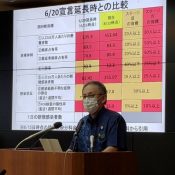
August 12, 2021 Ryukyu Shimpo
With the rapid spread of a new wave of COVID-19, Okinawa governor Denny Tamaki held a press conference at the Okinawa Prefectural Office on August 12, where he announced new coronavirus measures such as a plan to increase the speed of vaccine distribution. He specified that they were aiming to have 50% of all Okinawans receive at least one dose of the vaccine by the end of August, and to have 70% of people with at least one dose by the end of October. He also called on people to celebrate the Obon festival from August 20-22 with their families over the phone or online, and to refrain from visiting relatives in person.
The measure Okinawa prefecture had previously taken to close all public prefectural buildings until August 15 will also be extended to the end of the month. He is also asking large institutions to close over the weekend August 14-15, in line with the previous policy.
The vaccination distribution plan is in line with the national plan to get everyone vaccinated by November. Governor Tamaki explained, “I want the cities and towns to keep progressing along continuously.”
As of August 11, 33.5% of Okinawans have received at least the first dose of the COVID-19 vaccine. Okinawa Department of Health director Reiko Oshiro said of the midway goal of 50% by the end of August, “Recently we surpassed 10,000 shots in a single day in Okinawa, so we are within the realm of possibility.”
(English translation by T&CT and Sam Grieb)
Go to Japanese
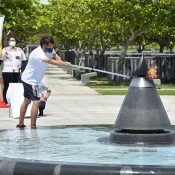
August 13, 2021 Ryukyu Shimpo
On August 12, torch bearers located in six towns and cities of Okinawa prayed for peace as they ignited torches for the 2020 Tokyo Paralympics, which will open on August 24. The six locations included the Fire of Peace monument at the Peace Memorial Park in Mabuni, Itoman City, and a memorial commemorating the passing of the Olympic Torch in 1964 in Kayo, Nago City. There are 14 torches ablaze in Okinawa, which will be joined into one single flame onAugust 14. The City of Naha will host a ceremony for the event, and the Paralympic flame will be sent off to Tokyo, the host city.
Torches were also lit in Naha City, Urasoe City, Yonabaru, and Kumejima on August 12, with a limited number of ceremony attendees to prevent the spread of COVID-19. While some cities canceled the celebration due to bad weather, Uruma City and Kadena withdrew from lighting torches altogether.
The flames from each region will not be physically joined during the flame unification and send-off ceremony on August 14, but images of the torches will be displayed to show the unity of the spirit. A Flame Gathering Ceremony will be held in Tokyo on August 20, where the Paralympic flames from all over Japan and Stoke Mandeville, England, the birthplace of the Paralympics, will be united to create a single flame.
(English translation by T&CT and Monica Shingaki)
Go to Japanese
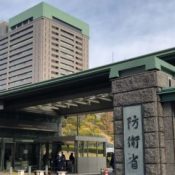
August 10, 2021 Ryukyu Shimpo
Tokyo – The Ministry of Defense (MoD) announced August 6 that they were adding three Japan Self Defense Force (JSDF) installations and seven U.S. military installations such as the U.S. Naha Military Port and JSDF Camp Naha to the list of locations that restricts the flying of unmanned aircraft (drones) as stipulated in the Drone Regulation Act. The rule goes into effect on August 16 for the JSDF installations, and September 9 for the U.S. military bases.
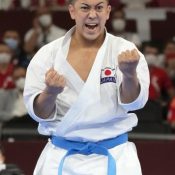
August 6, 2021 Ryukyu Shimpo
The Karate Men’s Karate Kata event was held for the first time in the Olympics at the Nippon Budokan on August 6, the 15th day of the Tokyo Olympics, and its first champion was Okinawan-native Ryo Kiyuna (31 – Konan High School, Okinawa International University, Ryuhouryu Ryueikai) was crowned the event’s first champion after defeating Spain’s Damian Quintero score of 27.66 with his own score of 28.72. This is the first time an Okinawan has won a gold medal in any event.
In the elimination rounds, Kiyuna competed in Pool B, posting a score of 28.26 for his Ohan in round one and 28.40 in round two for his Anan. Out of 11 competitors in Pool B, Kiyuna was the only one to score over 28, and with an average score of 28.33 he easily passed through the elimination rounds in first place. In the ranking round he scored a 28.72 for his Anan Dai, holding the top spot in Pool B. Hi Ohan Dai in the final highlighted his wire-to-wire domination of the event.
Ryo Kiyuna was born July 12, 1990. Since his third year in junior high, he has been studying under Tsuguo Sakumoto, 73, who was also the manager of Japan’s men’s kata Olympic team. This is his third-straight world championship. In December of last year, he also won his ninth-straight All-Japan championship.
This is the second medal won by an Okinawan at this Olympics after Shohei Yabiku (26 Urasoe Kogyo High School, Nippon Sport Science University, ALSOK) won the bronze in the Men’s under 77kg Greco-Roman wrestling.
Comments from Kiyuna: A message to his late mother, for the dreams of children in Okinawa
“I want to give thanks for being on this podium. I could not have done it alone. Now… I have to give thanks for everything. First, I want to be able to tell my (late) mother that I was victorious. I want the children of Okinawa to know that if they follow their dreams and never give up that they can succeed.”
(English translation by T&CT and Sam Grieb)
Go to Japanese

August 4, 2021 Ryukyu Shimpo
Shohei Yabiku, 26, gave a press conference in Tokyo on the morning of August 4, a day after winning third place in the men’s 77kg Greco-Roman wrestling final at the 2020 Summer Tokyo Olympics. Yabiku is an alum of Urasoe Technical High School, Nippon Sport Science University, and its Graduate School, and is sponsored by ALSOK. The Olympian commented, “I am receiving tons of [congratulatory] messages from people in Okinawa. It’s starting to hit me that I really won a medal.”
The night before, Yabiku had to wait a long time for a post-match doping test. “I ate dinner, then passed out as soon as I hit my futon,” he said with a smile. Promptly after his win, he phoned his father Tamotsu, 58, a former national wrestling champion who laid the foundation for Yabiku’s wrestling career. His father congratulated him with: “well, good job.” Yabiku plans to hang the bronze medal around his father’s neck the first thing he returns home.
Yabiku’s bronze win weighs heavy for Japan in the middleweight division where there are many foreign rivals. The Olympian commented ambitiously, “If I’m going to do this, I want to be the best in the world. I was able to identify some improvement points during the games. If I can work them out, I can get closer to first place.”
(English Translation by T&CT and Monica Shingaki)
Go to Japanese
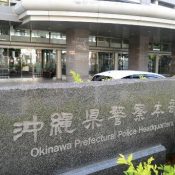
August 4, 2021 Ryukyu Shimpo
On August 3 the first security division of the Okinawa Prefectural Police filed documents with the Naha District Public Prosecutor’s Office concerning butterfly researcher Akino Miyagi being charged with forcible obstruction of business, a traffic law violation, and a violation of the Waste Disposal Act due to interfering with the duties of Northern Training Area (NTA)-related personnel by scattering glass shards, scrap metal, empty bottles, and the like at a former NTA site in front of a gate to the NTA. These documents were filed with an attached comment about strictly disposing of waste. In an interview with the Ryukyu Shimpo, Miyagi said, “This was merely a protest of the central government concealing the existence of U.S. military waste in order to achieve World Natural Heritage Site registration. Charges should not be filed against citizens who resist the power.”
Charges filed against Miyagi on April 7 have her under suspicion of having scattered glass shards, scrap metal, empty bottles, and the like in front of the NTA’s Higashi Village gate, thereby obstructing the duties of NTA-related personnel.
According to the prefectural police, Miyagi has been standing in the way of the NTA gate since 2020 and obstructing the passage of cars of personnel who are entering and exiting, and has been confirmed as having dumped bags of articles marked “waste” in front of the gate multiple times. The bags contained waste from the U.S. military that Miyagi had discovered at the former NTA site. The prefectural police have been receiving damage reports from NTA-related personnel. A spokesperson for the prefectural police explained that Miyagi has “repeatedly taken actions that qualify as crimes and has been issued instructions and warnings, but has not reformed her illegal activities.”
The Defense claims “act of returning garbage to U.S. military” such as uncollected ammunitions
While acknowledging her actions in front of the gate, Miyagi said, “This is to protest U.S. military waste that remains even now and to make known the existence of the waste.” She has voiced criticism, including, “This is an intervention against citizens who resist the power,” pertaining to how the prefectural police, that have investigated and filed the charges, are handling the situation.
The Okinawa Defense Bureau (ODB) implemented obstacle removal measures such as the removal of pollutants prior to a return site, which was a portion of the NTA, being returned in 2017. Even after the site was returned, a spokesperson for the ODB has said it would “coordinate with landowners and relevant agencies to collect and carry out proper disposal [of waste]” if new waste were to be confirmed at the site.
However, even now, waste originating from the U.S. military continues to be found. When Miyagi found, among other things, ammunitions containing gunpowder at the former NTA site, she reported it to the police. According to Miyagi, the prefectural police, who initially collected the waste, stopped taking notice around October 2019. A spokesperson for the prefectural police said, “We are taking required measures such as making necessary contact with relevant agencies,” but did not mention whether collection standards exist. Miyagi claimed that, “The ammunitions have not been collected and remain even now. It is ridiculous that this is not questioned, but that a citizen’s deeds are called into question.”
The lawyer Shunji Miyake pointed out that “It is oppressive conduct using the right to investigate. The act of returning discarded garbage to the owner, the U.S. military, does not strike against the ‘authorities’, in actuality.”
(English translation by T&CT and Erin Jones)
Go to Japanese
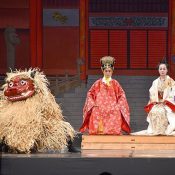
August 6, 2021 Ryukyu Shimpo
Kumiko Yoshihara in Wakayama – On August 5, the Traditional Arts Club of Haebaru High School won the grand prize, the Minister of Education’s award for excellence, in the Traditional Arts Category of the 45th All-Japan High School Culture Festival for the first time. The festival is being held in Wakayama Prefecture. The Yaeyama High School Traditional Arts Club performed on August 3 and received an award in the same category.
Mei Nakazato is the president of Haebaru High School’s Traditional Arts Club. She says, “Everyone worked really hard on the performance, so I’m so happy that we won! I’m looking forward to having fun dancing beautifully at the Tokyo performance.”
The last time that a school in Okinawa won the grand prize in this category was 19 years ago, when Yaeyama High School won in 2002. Haebaru High School will be performing at a showcase of the best performances, which will be held at the National Theater in Tokyo at the end of August.
(English translation by T&CT and Ellen Huntley)
Go to Japanese
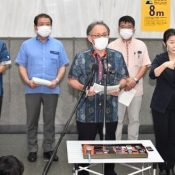
August 2, 2021 Ryukyu Shimpo
Okinawa Governor Denny Tamaki, who is grappling with the rapid spread of COVID-19 in Okinawa, held a meeting at the Okinawa Prefectural Office August 1 with representatives from the medical and business communities as well as Okinawa’s municipalities, after which they announced a join emergency declaration calling for people to self-isolate for the next two weeks, until August 15.
This is the first time a joint message has been issued by representatives from these four groups. With the spread of the disease in Okinawa, “at a level that would be suitable for a lockdown in any other country,” and explained the severe danger of the situation which could result in the collapse of Okinawa’s healthcare system.
Okinawa confirmed 367 new cases of COVID-19 on August 1. This is the sixth-straight day that new cases were over 300, and as of 1:00 p.m. the number of people receiving medical care, including both those in the hospital and people receiving care at home, was 2,757. The 2,397 cases in the past week are the most ever in Okinawa.
The joint emergency declaration focused on three points: 1. Do not gather either outside or in homes, and stay at home; 2. Do not travel to other prefectures or neighboring islands, even to visit home; 3. Be proactive in getting vaccinated.
After the meeting, Governor Tamaki said, “As expected, containing the flow of people, and limiting contact between people is important. We want people to practice restraint and engage in a self-lockdown.”
Okinawa Medical Association president Tetsuyoshi Asato reported that the increase of COVID-19 patients has disrupted medical facilities, and due to the limited availability of hospital beds, “People who need to go to the hospital cannot, and I am of utmost concern for those who fall into critical condition.” He explained the necessity for the elderly as well as people age 40-65 to get vaccinated quickly.
The Okinawa Chamber of Commerce and Industry President Denichiro Ishimine added to the emergency declaration, touching on the particularly severe economic impact this will have on the food and hospitality industry, saying, “Understand that controlling the spread of disease is the best economic policy, and let’s knock this out over the next two weeks.”
The meeting was private except for the opening, and they discussed making an appeal to people who have already been vaccinated as well. After the meeting, Governor Tamaki commented, “People who have received both doses of the vaccines have found a degree of freedom in their lives. With this kind of incentive, we will work with the business community on tackling this issue.”
(English translation by T&CT and Sam Grieb)
Go to Japanese











 Webcam(Kokusai Street)
Webcam(Kokusai Street)


